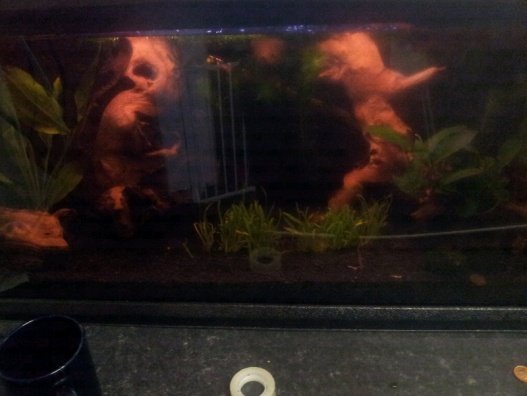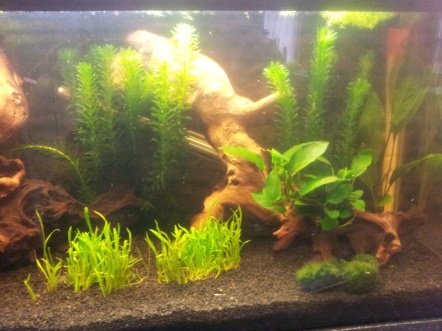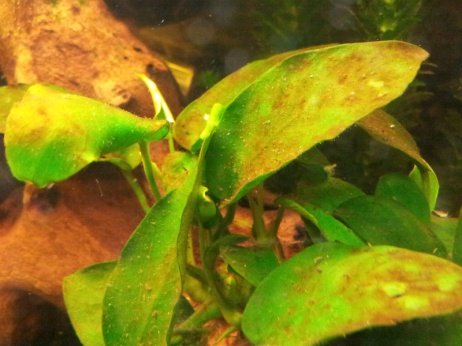You are using an out of date browser. It may not display this or other websites correctly.
You should upgrade or use an alternative browser.
You should upgrade or use an alternative browser.
whats this brown stuff
- Thread starter lornajane89
- Start date
The friendliest place on the web for anyone with an interest in aquariums or fish keeping!
If you have answers, please help by responding to the unanswered posts.
If you have answers, please help by responding to the unanswered posts.
FreshwaterFishJunkie
Aquarium Advice Activist
From the looks of it is is either lack of nutrients for the plants or brown algae
"
Cause
"
Cause
- Excess silicates & nitrates
- Inadequate light
- Low oxygen levels
Talvari
Aquarium Advice FINatic
- Joined
- Sep 7, 2011
- Messages
- 732
Looks like diatoms to me... A type of Algae that is pretty common on plants and in new tanks, from what I remember being told.
FreshwaterFishJunkie
Aquarium Advice Activist
FYI:
"
Brown diatoms algae are a widespread group or algae that can be found in the oceans, in freshwater, in soils and on damp surfaces. They have yellow-brown photosynthetic pigments, so most forms appear brownish to us. They are a major group of unicellular eukaryotic algae, and are one of the most common types of phytoplankton. A characteristic feature of diatom cells is that they are encased within a unique cell wall made of silica (hydrated silicon dioxide) called a frustule. Fossil evidence suggests that they originated during, or before, the early Jurassic Period.
Brown diatom algae in the aquarium:
Every aquarium experiences a bloom of brown diatom algae at one time or an other. In most case, this is likely to happen at the end of the cycling phase or just after and may disappear as quickly as it arrived when the conditions stabilize after a couple of months.
Excess silicates
Brown diatom algae require silicates to grow. Silicate may be present in your tap water and may be the source of the problem. Many also believe play sand or other silica based substrate may trigger a Brown diatom algae bloom. Both Seachem and Salifert make silicate test kits so you might want to get one before to assume silicates can be the cause of the problem. If you find silicate in your water, you might want to test your tap water.
Excess nutrients & organics
The cycling period is a time where the water may contains high levels of organic carbons and No2 but low levels of No3 and Po4. Brown diatom algae seem to thrive in these conditions.
Excess iodine
Too much iodine in the water leads to brown algae. Check the label on any additives you use. Many contain significant amounts of iodine.
Brown diatom algae control
Water changes
A good maintenance routine and regular water changes will help lot. In established tank, if a brown algae bloom is followed by cyanobacteria, your problem is clearly due to dissolved organics compound in the water. If you maintain good water quality, in time (weeks to a few months) the diatoms are likely to die back or even disappear.
Manual removal
Brown diatom algae don’t have any firm attachment to the surface on which they are found so they clean off easily. A good way to control their growth is to remove as mush as you can during water changes. So do that, wipe them off.
Silicates removal:
If your water supply has moderate dissolved silicates (3-4ppm), you will likely see persistent diatoms in the lower-light areas of the tank. Using reverse osmosis instead of tap water can be a good way to fix the problem. Another way is to remove silicates with phosphate removers (they also remove silicates) such as Seachem’s PhosGuard, Metal Gone and Kent’s Phosphate Sponge.
Time is your ally:
As the tank matures, diatom problems tend to fade. Should such tanks have some major biological upset requiring frequent large-scale water changes, the diatoms may reappear. They should fade again when the tank returns to more conventional handling and upkeep.
Critters:
Some critters are particularly good at eating brown algae. Otocinclus catfish, seem to be the best fish for the job, although you may need several for larger tanks. Snails such as the Ramshorns snail and Olive nerites are also some great choices. I know some shrimps will also eat brown algae but I have no experiences with them.
Live plants:
The addition of live plants generally help lot. " - Brown Diatom Algae Control | Aquariums Life
"
Brown diatoms algae are a widespread group or algae that can be found in the oceans, in freshwater, in soils and on damp surfaces. They have yellow-brown photosynthetic pigments, so most forms appear brownish to us. They are a major group of unicellular eukaryotic algae, and are one of the most common types of phytoplankton. A characteristic feature of diatom cells is that they are encased within a unique cell wall made of silica (hydrated silicon dioxide) called a frustule. Fossil evidence suggests that they originated during, or before, the early Jurassic Period.
Brown diatom algae in the aquarium:
Every aquarium experiences a bloom of brown diatom algae at one time or an other. In most case, this is likely to happen at the end of the cycling phase or just after and may disappear as quickly as it arrived when the conditions stabilize after a couple of months.
Excess silicates
Brown diatom algae require silicates to grow. Silicate may be present in your tap water and may be the source of the problem. Many also believe play sand or other silica based substrate may trigger a Brown diatom algae bloom. Both Seachem and Salifert make silicate test kits so you might want to get one before to assume silicates can be the cause of the problem. If you find silicate in your water, you might want to test your tap water.
Excess nutrients & organics
The cycling period is a time where the water may contains high levels of organic carbons and No2 but low levels of No3 and Po4. Brown diatom algae seem to thrive in these conditions.
Excess iodine
Too much iodine in the water leads to brown algae. Check the label on any additives you use. Many contain significant amounts of iodine.
Brown diatom algae control
Water changes
A good maintenance routine and regular water changes will help lot. In established tank, if a brown algae bloom is followed by cyanobacteria, your problem is clearly due to dissolved organics compound in the water. If you maintain good water quality, in time (weeks to a few months) the diatoms are likely to die back or even disappear.
Manual removal
Brown diatom algae don’t have any firm attachment to the surface on which they are found so they clean off easily. A good way to control their growth is to remove as mush as you can during water changes. So do that, wipe them off.
Silicates removal:
If your water supply has moderate dissolved silicates (3-4ppm), you will likely see persistent diatoms in the lower-light areas of the tank. Using reverse osmosis instead of tap water can be a good way to fix the problem. Another way is to remove silicates with phosphate removers (they also remove silicates) such as Seachem’s PhosGuard, Metal Gone and Kent’s Phosphate Sponge.
Time is your ally:
As the tank matures, diatom problems tend to fade. Should such tanks have some major biological upset requiring frequent large-scale water changes, the diatoms may reappear. They should fade again when the tank returns to more conventional handling and upkeep.
Critters:
Some critters are particularly good at eating brown algae. Otocinclus catfish, seem to be the best fish for the job, although you may need several for larger tanks. Snails such as the Ramshorns snail and Olive nerites are also some great choices. I know some shrimps will also eat brown algae but I have no experiences with them.
Live plants:
The addition of live plants generally help lot. " - Brown Diatom Algae Control | Aquariums Life
Talvari
Aquarium Advice FINatic
- Joined
- Sep 7, 2011
- Messages
- 732
I have ghost shrimp in my 46 gallon tank and I know for a fact that they do eat the diatoms. Many evenings I find the shrimp perched on the plants, cleaning off and eating the algae.
lornajane89
Aquarium Advice Freak
Cant really have shrimp cause of my fish, kuhlis, african bushfish, african butterfly fish. I suspect all will eat them, dont know about snails tho i have alot of little "pest" snails in there which i always kinda thought as a freebie lol and they dont get bothered so snails and manual cleaning might be an option.
To be honest my lights have been appalling until recently so i think that may have been the problem i have since bought a new hood and light set up
Before

And after

Also its only been cycled since the start of november so that may also be the cause. I do feed the plants, its only petsmart bottled plant food so i dont know how good it is but the plants are growing.
To be honest my lights have been appalling until recently so i think that may have been the problem i have since bought a new hood and light set up
Before

And after

Also its only been cycled since the start of november so that may also be the cause. I do feed the plants, its only petsmart bottled plant food so i dont know how good it is but the plants are growing.
Similar threads
- Replies
- 3
- Views
- 532
- Replies
- 6
- Views
- 468
- Replies
- 1
- Views
- 217
- Replies
- 3
- Views
- 881
- Replies
- 3
- Views
- 527

